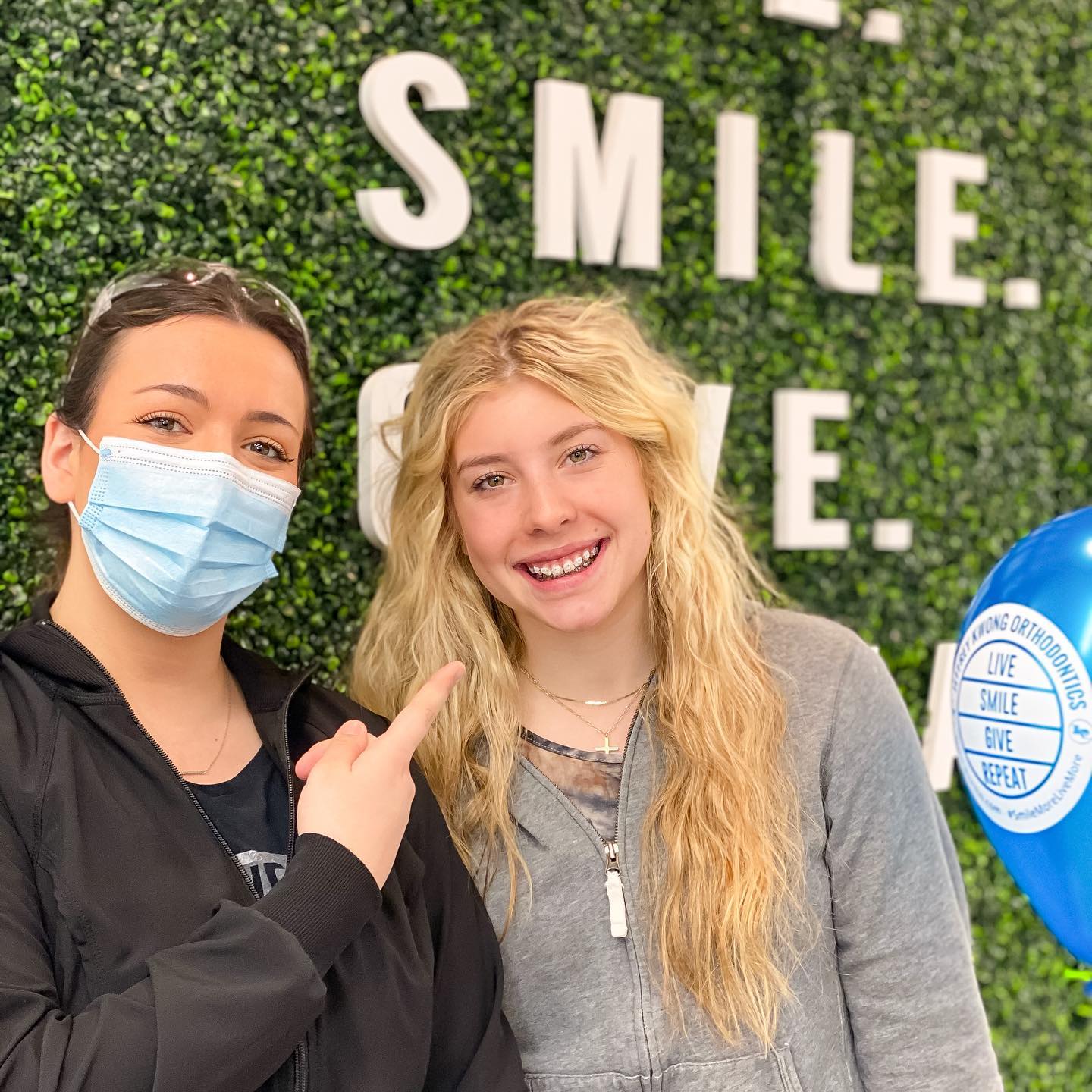
So, you’re thinking about kicking off braces or Invisalign treatment to bring out the best in your smile? You probably know the basics of both treatment options. One involves brackets and wires, while the other relies on a series of custom clear aligners designed by your orthodontist. But did you know there are actually different stages of braces and Invisalign treatment? As an El Dorado Hills, CA orthodontist, I don’t just glue brackets to the teeth or hand patients aligners and call it a day. To get optimal results that last a lifetime, orthodontic treatment involves careful planning and follows a tried-and-true sequence.
In this post, I’ll cover:
Table of Contents
What are the Stages of Braces or Invisalign Treatment?
There are three general stages of braces and Invisalign treatment: the planning stage, the active stage, and the retention stage. All three phases are super important. Without intensive upfront planning, your teeth wouldn’t move where we want them to, and the orthodontist would be constantly making tweaks, leading to years and years spent wearing an appliance, or subpar results (we’re looking at you, mail-order clear aligners). And though the active stage is what comes to mind when everyone thinks of orthodontic treatment, it would all be for nothing if it weren’t followed by the retention stage to hold the teeth in their new places.
What Happens During the Planning Stage of Orthodontic Treatment?
The planning stage is where the behind-the-scenes work begins. As your orthodontist, I’m the one who plans where and when each tooth will move during treatment, as well as how to align the bite. One of the benefits of seeing the same Orthodontist throughout your entire treatment is that it allows continuity in executing the plan, and it helps minimize treatment time and disruption.
At Jeffrey Kwong Orthodontics, we take a personalized and high-tech approach. When you come in for your initial orthodontic consultation, a team member will take digital x-rays and photos, and I’ll perform an exam. I’ll use your diagnostic records and my findings to determine a diagnosis and give you personalized treatment recommendations.
At Jeffrey Kwong Orthodontics, I offer a variety of different types of braces, including:
Once you decide on your preferred treatment option, then the real planning starts. Instead of goopy, messy molds, we take digital dental impressions using our iTero® scanner. A team member will use a small, handheld wand to capture images of your teeth and gums. The scans will be uploaded to our computer and a digital, 3D model of your mouth will be created.
For digitally-driven treatments like Invisalign and InBrace, I’ll move your teeth directly on the model of your mouth. This lets me visualize different outcomes and troubleshoot in advance before you start treatment. I can also show you a virtual simulation of what your new smile will look like!
With traditional and clear braces, the plan starts in the room with you. All the nerdy tooth talk you’re hearing is about how we’re going to move your teeth, and where we’re going to position the braces specifically to address different aspects of your bite. Once you know that, I’ll be able to put on your metal braces or clear braces.
If you opt for Invisalign or InBrace, I’ll send the specifications to the lab. They’ll print custom clear aligners or deliver trays for InBrace based on my InBrace or Invisalign treatment plan.
What Happens During the Active Stage of Braces or Invisalign Treatment?
The active stage of orthodontic treatment is where the action happens. This is when the teeth shift into place and we align the bite. While there are some variations when comparing Invisalign vs. braces, the basic mechanics are the same.
The braces or aligners exert steady, gentle pressure that stimulates the natural biological process of bone remodeling. The ligaments that support the teeth loosen and the supporting bone and tissues break down. This lets the teeth move where they’re directed by your appliance. Don’t worry, while that does sound kind of horrifying, it’s painless and something that happens within your body all of the time without you knowing!
Within this larger, general stage, there are other substages of treatment. Though every patient is unique and the exact course of your treatment will depend on your individual case, for common smile concerns like an overbite, open bite, or crowding, the active phase of your treatment will include:
- Aligning and Leveling
The initial stage of braces and Invisalign is dedicated to aligning and leveling the teeth. Aligning means derotating and straightening your teeth to make a nice arch form or curve for your teeth (think about looking straight down at your teeth from above them). Leveling means fixing vertical discrepancies by ensuring teeth are the same height within the arches.
- Correcting the Bite
In the next step of the active stage of orthodontic treatment, we need to get the relationship between the molars correct, close any spaces, and ensure the upper and lower teeth come together properly. When the teeth move, the bite will also change.
That’s why I spend time addressing the front-to-back, side-to-side, and top-to-bottom tooth relationships and helping the upper teeth fit ideally over the lower teeth when you close your mouth. Since braces and Invisalign straighten the teeth in each arch independently, if we need to reposition the jaws to correct the bite, I may use auxiliaries like rubber bands to provide the necessary connective forces. There’s a good chance we’ll start rubber bands early, so that we can get that part out of the way as quickly as we can.
- Finishing
I wrap up the active phase of comprehensive orthodontic treatment with the finishing stage. I take a look at the aesthetics of your smile, your occlusion (bite), and how everything has come together. If necessary, I make final adjustments like reshaping the teeth, bending your wires, or repositioning the braces to finetune your smile. I also plan for the removal of your braces, as well as your retention stage.
What to Expect During the Retention Stage of Orthodontic Treatment?
Once the active stage of your treatment is complete, there’s one more step and that’s the retention stage. During the retention stage, you wear a retainer, or retainers, to hold your teeth in their new positions. This allows the periodontal ligaments to tighten back up and new bone to form around the teeth, securing them within the jaw.
If you don’t wear a retainer after Invisalign or braces, the teeth have a natural tendency to shift back towards their old places, potentially causing a relapse and the need for another round of orthodontic treatment.
There are a few different types of orthodontic retainers, including:
- Permanent Retainers – A permanent retainer consists of a piece of wire that is bonded to the back of your teeth using special adhesive. It’s a fixed appliance, meaning it stays in place and isn’t removable. It’s not visible at all when you smile.
- Hawley Retainers –This is the traditional retainer that you’re thinking about in your head. There is a thin, metal wire that wraps around the front teeth, with acrylic that fits against the roof or bottom of the mouth. Hawley retainers are removable, but they are more visible than the other types of retainers.
- Essix Retainers – An Essix retainer is a clear, plastic retainer, sometimes referred to by patients as an Invisalign retainer. A clear retainer fits over your teeth like an Invisalign aligner. It’s comfortable, removable, and virtually invisible. Ask us about our retainer guarantee. This is where we differ from other practices, and this is where we can save you and your family hundreds to thousands of dollars in replacement retainers.
While I’ll give you specific retainer instructions based on your needs, most patients wear their retainer(s) full time at the start of the retention stage. Then, they transition to wearing it just at night. Eventually, you may only need to wear your retainer a few nights a week. Since your bite naturally changes with age, in an ideal world, most people would use a retainer for life.
Schedule a Complimentary Consultation to Start Your Smile Journey
Now that you know what the different stages of braces and Invisalign treatment entail, are you ready to get straight teeth, a healthy bite, and a fantastic new smile? Schedule a complimentary consultation at Jeffrey Kwong Orthodontics in El Dorado Hills, California today!

